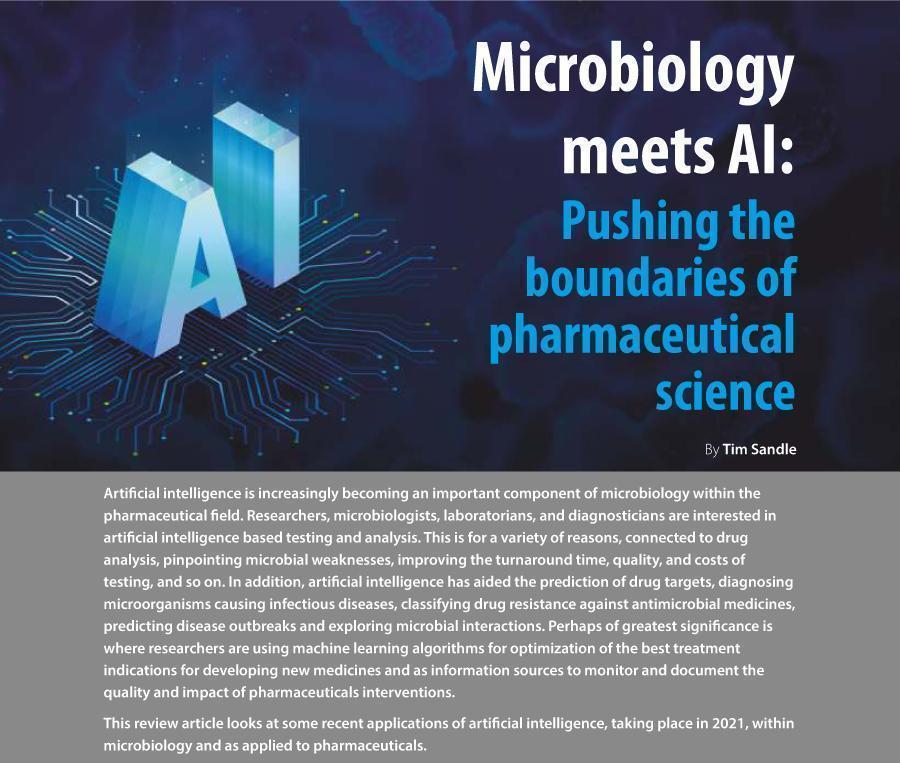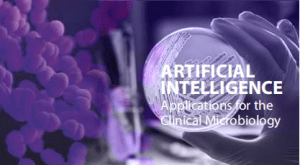
By: Tim Sandle
Bacterial sensors to improve mental health
Microbiome research, which has advanced through the development of microbial sequencing methods, has paved the way for novel drug treatments (1), with inference drawn from artificial intelligence. High High through put sequencing technology has resulted in generation of an increasing amount of microbial data and this requires the application of approaches like
machine learning to interpret it.
For example, future treatments for gastrointestinal diseases and disorders such as irritable bowel syndrome, inflammatory bowel disease and slow transit constipation, among others, have been advanced through advances in computational research and machine learning (2), both supervised learning and unsupervised learning. Many of these are types of personalised (or ‘precision’) medicines, targeting for specific patients or smaller groups of patients rather than being targeted for the population at large.
 Furthermore, it has been established for several years that the bacteria living in the gut can synthesize some of the neurotransmitters (chemicals that transmit signals from nerve cells to target cells), that are responsible for a person’s nerves, anxiety, and euphoria. An imbalance of the bacterial population, in relation to the types of species, leads to changes with the levels of hormones and consequently a person’s mental health can suffer. For example, 95 percent of the
Furthermore, it has been established for several years that the bacteria living in the gut can synthesize some of the neurotransmitters (chemicals that transmit signals from nerve cells to target cells), that are responsible for a person’s nerves, anxiety, and euphoria. An imbalance of the bacterial population, in relation to the types of species, leads to changes with the levels of hormones and consequently a person’s mental health can suffer. For example, 95 percent of the
hormone serotonin is synthesized by bacteria in the gut. Serotonin is the key hormone that stabilises a person’s mood, feelings of wellbeing, and happiness. This hormone enables brain cells and other nervous system cells to communicate with each other. Serotonin also plays a role in relation to sleeping, eating, and digestion.
Researchers at McKelvey School of Engineering at Washington University in St. Louis have demonstrated how genetically engineered bacteria that can monitor chemical production from inside a person’s gut and fix any imbalances (3). This is based around engineering beneficial bacteria, in the form of a probiotic, specifically aimed at protecting people from the negative health effects of adrenaline surges. Probiotics are live bacteria and yeasts promoted as having various health benefits.
The monitoring of the imbalance was established through the development of a “bacterial sensor” that can detect certain chemicals in a person’s gut. The sensors detectvariations in temperature, pH, oxygen levels, light, pollutants and other disease-related chemicals, each of which can signal the effects of a bacterial imbalance. An example is with genetically engineered Escherichia coli Nissle 1917 (EcN). E. coli strain Nissle 1917 (trade names Mutaflor® or ECN) is a Gramnegative microorganism with probiotic properties that has been successfully used for the treatment of intestinal inflammation, especially in patients suffering from ulcerative colitis.
Through the use of artificial intelligence, with the recent study, it was possible to develop computer modelling to explore how mutations would affect the pathway’s sensitivity. Through this, the researchers were able to develop a sensor pathway that was sensitive to the molecules they were interested in (and for the sensor to be specific only to the molecules of interest).
 With the EcN sensor, the modified bacteria become “precision hunters”. Taking a genetic disease example, the organisms can discriminate between phenylalanine and tyrosine, which are two structurally similar molecules associated with the disorders like type 2 tyrosinemia. For the neurotransmitter application, the objective is that when the levels are too high, the bacteria will produce an enzyme that degrades the target chemical. Conversely, if it is too low, the bacteria produce an enzyme that can synthesize more of the neurotransmitter.
With the EcN sensor, the modified bacteria become “precision hunters”. Taking a genetic disease example, the organisms can discriminate between phenylalanine and tyrosine, which are two structurally similar molecules associated with the disorders like type 2 tyrosinemia. For the neurotransmitter application, the objective is that when the levels are too high, the bacteria will produce an enzyme that degrades the target chemical. Conversely, if it is too low, the bacteria produce an enzyme that can synthesize more of the neurotransmitter.
Developing drugs to reduce biofilms on drug delivery system
 When investigating the key proteins in biofilms of the fungus Candida albicans, to understand how the proteins control, how the organism resists antifungal drugs as well as how the proteins aid the dispersal of the fungus throughout the human body, researchers pinpointed the sticky, armour-like structures that build a biofilm matrix (4). The biofilm acts to encase clusters of disease-causing organisms, providing protection from antifungal drugs. Such research is of pharmacological importance, given that there are no approved antimicrobials to treat biofilms. The only way to treat a biofilm is to physically remove it from the body.
When investigating the key proteins in biofilms of the fungus Candida albicans, to understand how the proteins control, how the organism resists antifungal drugs as well as how the proteins aid the dispersal of the fungus throughout the human body, researchers pinpointed the sticky, armour-like structures that build a biofilm matrix (4). The biofilm acts to encase clusters of disease-causing organisms, providing protection from antifungal drugs. Such research is of pharmacological importance, given that there are no approved antimicrobials to treat biofilms. The only way to treat a biofilm is to physically remove it from the body.
 Candida is an enigmatic organism. The fungus often makes its home in and on healthy people, to no ill effect. However, it can readily infect immunocompromised individuals. The newly identified proteins from the research provide potential drug targets to impair a pathogen’s antimicrobial defences. The study demonstrated that Candida could not make some of these proteins were much more sensitive to the existing antifungal fluconazole.
Candida is an enigmatic organism. The fungus often makes its home in and on healthy people, to no ill effect. However, it can readily infect immunocompromised individuals. The newly identified proteins from the research provide potential drug targets to impair a pathogen’s antimicrobial defences. The study demonstrated that Candida could not make some of these proteins were much more sensitive to the existing antifungal fluconazole.
The researchers used a machine learning algorithm to screen through hundreds of proteins to identify likely candidates involved in biofilm production and function. Through the analysis, the scientists identified 63 proteins to investigate further. The investigations involved developing Candida mutants that were unable to make specific proteins. This stage revealed 13 variants of the fungus became more susceptible to the antifungal fluconazole. Following laboratory studies, animal models to test drug resistance were created using rodents and venous catheters. These catheters, inserted into large veins, are often left in place for months to help deliver drugs, such as during chemotherapy treatment. Because they spend a long time in the body, catheters are prone to becoming sources of infection, and hence the catheter was of importance in terms of biofilms and drug delivery systems. Through the rat models, four of the 13 drugsensitive fungal mutants remained susceptible to fluconazole, reducing fungal populations down by 30-fold or more. An additional significance is that because biofilms shape the lifecycle of the organisms contained within them, body-wide dispersal is decreased by reducing the scope of the biofilm and the types of Candida contained within the slime-like structures. This arises since the identified proteins also play complex roles in biofilms (5).
Detecting disease likelihood
Insights into how bacterial proteins work as a network to take control of human cells could help predict infection outcomes and develop new treatments. Pathogenic bacteria use miniature molecular syringes to inject specific agents (called effectors). These injections are often made into the cells that keeps the gut healthy. These effectors take control of our cells, overwhelming their defences and blocking key immune responses, allowing the infection to take hold.
Researchers at Imperial College London and The Institute of Cancer Research, London have studied whole sets of effectors in different combinations. These involved experiments conducted using miceinfected with Citrobacter rodentium, which injects 31 effectors (the bacterium is a mucosal pathogen of mice that shares several pathogenic mechanisms with enteropathogenic E. coli). The results show how effectors work together as a network, allowing them to colonise their hosts even if some effectors are removed. The investigation also revealed how the host’s immune system can bypassthe obstacles the effectors create, triggering complementary immune responses.
The researchers suggest that knowing how the makeup of effector networks influences the ability of infections to take hold could help design interventions that disrupt their effects. This leads the research team to predict how a cell will respond when attacked by different combinations of bacterial effector proteins. Such insights will help scientists to better understand how cells, the immune system and bacteria interact, and this can be applied to understanding and pharmacologically treating diseases like cancer and inflammatory bowel disease. These are diseases where bacteria in the gut play animportant role.
During the experiments, the research group was able to remove different effectors when infecting mice with the pathogen, tracking how successful each infection was. This showed that the effector network produced by the pathogen could be reduced by up to 60 percent and still produce a successful infection.The researchers collected data on more than 100 different synthetic combinations of the 31 effectors. These data points were used to build an artificial intelligence algorithm.The AI model was able to predict the outcomes of infection with C. rodentium expressing different effector networks, which were tested with experiments in mice (6). As it is impossible to test in the lab all the possible networks that 31 effectors can form, employing an artificial intelligence model is the only practical approach to studying biological systems of this complexity. Such combinations would not be obvious from our experimental results alone, opening the possibility of using artificial intelligence to predict infection outcomes.
Moreover, going forwards the data can be built upon by other researchers with an interest in using artificial intelligence and synthetic biology. This will be useful in allowing microbiologists to ascertain which cell functions are essential during infection. In turn, this will enable future scientists to find ways to fight the infection not by killing the pathogen with antibiotics, but instead by changing and improving our natural defence responses to infection.
Machine learning to identify likelihood of gene transfer as an antibiotic resistance mechanism
One of the primary mechanisms for antibiotic resistance is the consequence of the ability of bacteria to pass genes to each other through horizontal gene transfer. To attempt to exploit any weakness in this process, Cornell University researchers used machine learning to sort organisms by their functions and use this information to predict how genes are transferred between them. This is an approach that could be used to reduce the spread of antibiotic resistance (7).

This is through understanding which organisms bacteria were exchanging and hence to unravel the driving factors that implicate organisms in this transfer. By gaining a deeper insight into how this happens could lead to the development of drugs to control these processes. For this, machine learning was used to assess bacteria genomes and their various functions in order to identify signatures that indicate the types of bacteria that were swapping genes and the form of the networks of exchange. To do so took several machine-learning models in order to assess different phenomena embedded in a vast array data. The output enabled the researchers to identify multiple networks of different antibiotic resistance genes, and across strains of the same organism. The model was tested out on bacteria isolated from soil, plants, and humans.
The research succeeded in finding that the network of bacterial gene exchange — specifically for antibiotic resistance is predictable. This means by examining the genomes of pathogens, predictive models can be constructed. This includes antibiotic resistance transfers between human associated bacteria and pathogens that have yet to be observed. This should researchers to select a specific antibiotic, depending what is observed in a specific patient’s gut.
Extracting compounds of value
The association between microorganisms and pharmaceutical processing is not always about finding ways to kill cells, for valuable compounds can be extracted from microorganisms and used within biotechnological processing. An example is with enzymes, the protein molecules comprised of chains of amino acids that act to speed up, or catalyse, the conversion of one kind of molecule (substrates) into another (products). In so doing, enzymes enable reactions such as digestion and fermentation to happen far more quickly and hence allow therapeutic compounds of value to be produced to scale.
With enzymes, details surrounding how their forms connect to their functions, and how they function with such extraordinary speed and specificity, are still not well understood. To gain an insight, scientists from the University of Stamford have developed a technique called High-Throughput Microfluidic Enzyme Kinetics (HTMEK) (8). This technique allows thousands of enzyme experiments to be performed simultaneously. The process deeply probes beyond the small “active site” of an enzyme where substrate binding occurs, to reveal clues about how more distant parts of enzymes work together to achieve their reactivity.
One application of HT-MEK is to explore bacteria, specifically engineered bacteria designed to produce a particular enzyme. This is through HT-MEK combining two existing technologies to rapidly speed up enzyme analysis. The first is microfluidics, which involves moulding polymer chips to create microscopic channels for the precise manipulation of fluids. The second technology is cell-free protein synthesis, this takes only those crucial pieces of biological machinery required for protein production and combines them into a soupy extract that can be used to create enzymes synthetically, without requiring living cells to serve as incubators.
Since the vast amount of data that HT-MEK generateswould require many months to process at a time, computational approaches and machine learning algorithms are being developed in parallel. These are designed to deduce an enzyme’s complicated 3D shape from its amino acid sequence alone.
Since each tiny chamber within the HT-MEK contains only a thousandth of a millionth of a litre of material, the scientists can engineer thousands of variants of an enzyme in a single device and study them in parallel. By tweaking the DNA instructions in each chamber, they can modify the chains of amino acid molecules that comprise the enzyme. In this way, it’s possible to systematically study how different modifications to an enzyme affect its folding, catalytic ability and ability to bind small molecules and other proteins. It is hoped the HTMEK process will accelerate an approach to drug development termed allosteric targeting, which aims to increase drug specificity by targeting beyond an enzyme’s active site. Enzymes are popular pharmaceutical targets because of the key role they play in biological processes. However, some enzymes are considered “undruggable” because they belong to families of related enzymes that share the same or very similar active sites and targeting them can lead to side effects.
The idea behind allosteric targeting is to create drugs that can bind to parts of enzymes that tend to be more differentiated, like their surfaces, but still control particular aspects of catalysis. HT-MEK may even allow scientists to reverse-engineer enzymes and design bespoke varieties of their own. This shares parallels with the application of artificial intelligence in other fields of pharmaceutical science. For example, AI can assist in structure-based drug discovery by predicting the 3D protein structure because the design is in accordance with the chemical environment of the target protein site, thus helping to predict the effect of a compound on the target along with safety considerations before their synthesis or production.
Summary
This article has presented five applications of artificial intelligence and the subset machine learning to the field of microbiology, citing examples that are, or have the potential to, reshape pharmaceutical production. In each case, the underlying driver is to the use of automated algorithms to perform tasks which traditionally rely on human intelligence. Through this new or faster insights can be made, and these can be used to either speed up drug discovery, or disease diagnosis, or to find faster means to combat pathogens in the fast-changing situation of antimicrobial resistance.
Future treatments for gastrointestinal diseases and disorders such as irritable bowel syndrome, inammatory bowel disease and slow transit constipation, among others, have been advanced through advances in computational research and machine learning, both supervised learning and unsupervised learning.
 Tim Sandle is the author of the book Digital Transformation and Regulatory Considerations for Biopharmaceutical and Healthcare Manufacturers, Volume 1: Digital Technologies for Automation and Process Improvement, available via the PDA Bookstore: https://www.pda.org/bookstore/product-detail/5897-digitaltransformation-volume-1
Tim Sandle is the author of the book Digital Transformation and Regulatory Considerations for Biopharmaceutical and Healthcare Manufacturers, Volume 1: Digital Technologies for Automation and Process Improvement, available via the PDA Bookstore: https://www.pda.org/bookstore/product-detail/5897-digitaltransformation-volume-1
References
1. Wilder, C., Sandle, T. and Sutton, S. (2013). Implications of the Human Microbiome on Pharmaceutical Microbiology, American Pharmaceutical Review, 16 (5): pp17-21
2. Vicentini, F., Keenan, C., L. et al. Intestinal microbiota shapes gut physiology and regulates enteric neurons and glia. Microbiome, 2021; 9 (1) DOI: 10.1186/s40168-021-01165-z
3. Rottinghaus, A., Xi, C., Amrofell, M. et al. Engineering ligand-specific biosensors for aromatic amino acids and neurochemicals. Cell Systems, 2021; DOI: 10.1016/j.cels.2021.10.006
4. Abd El-Baky RM, Sandle T, John J, Abuo-Rahma GE, Hetta HF (2019) A novel mechanism of action of ketoconazole: inhibition of the NorA efflux pump system and biofilm formation in multidrug-resistant Staphylococcus aureus, Infection and Drug Resistance, 12: 1703-1708
5. Zarnowski, R., Noll, A., Chevrette, M. et al. Coordination of fungal biofilm development by extracellular vesicle cargo. Nature Communications, 2021; 12 (1) DOI: 10.1038/s41467-021-26525-z
6. Ruano-Gallego, D., Sanchez-Garrido, J., Kozik, Z., et al. Type III secretion system effectors form robust and ??exible intracellular virulence networks. Science, 2021; 371 (6534): eabc9531 DOI: 10.1126/science.abc9531
7. Yarmarkovich, M., Marshall, Q., Warrington, J. et Cross-HLA targeting of intracellular oncoproteins with peptide-centric CARs. Nature, 2021; DOI: 10.1038/s41586-021-04061-6
8. Markin, C., D. Mokhtari, A., Sunden, F. Revealing enzyme functional architecture via high-throughput microfluidic enzyme kinetics. Science, 2021; 373 (6553): eabf8761 DOI: 10.1126/science.abf8761













